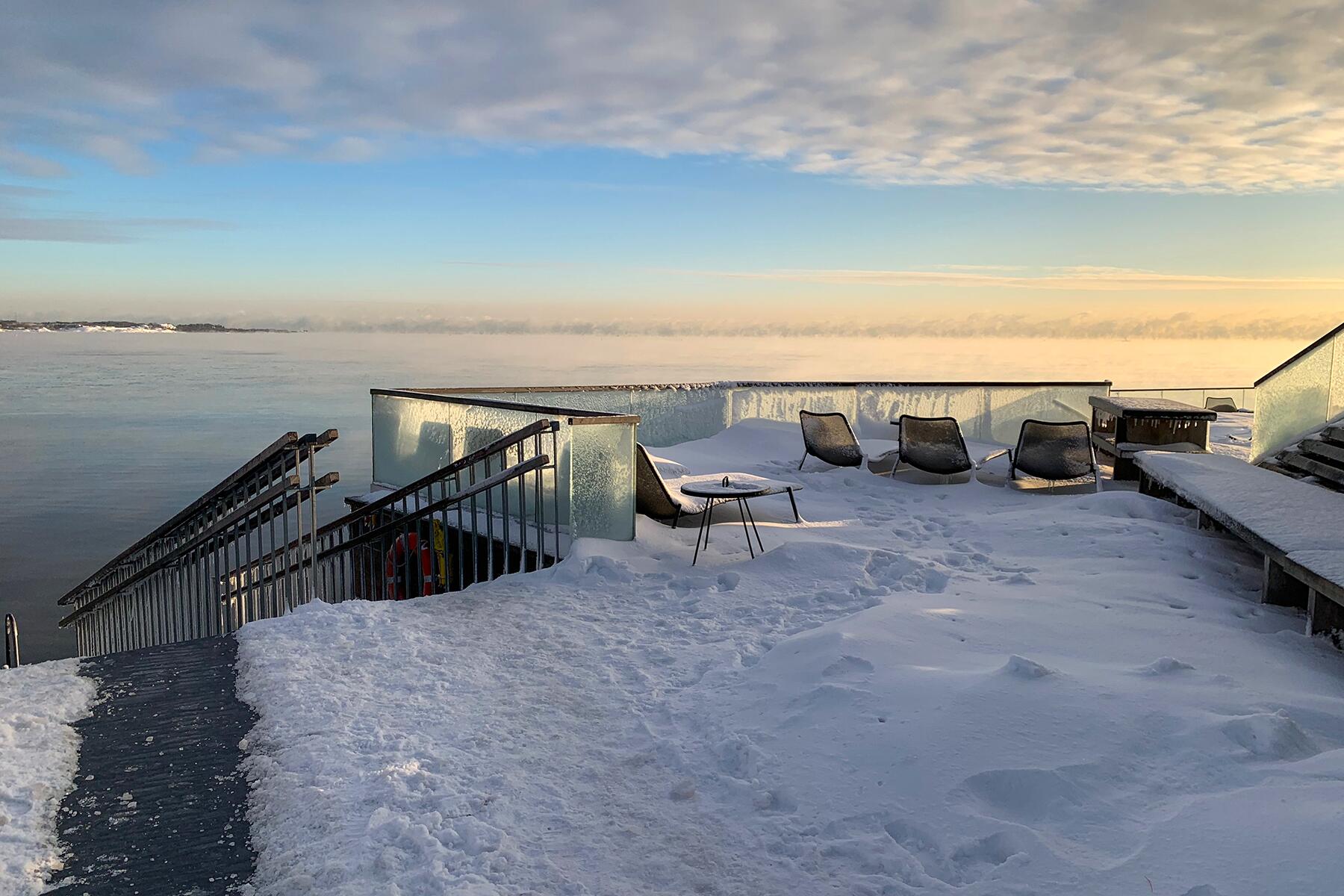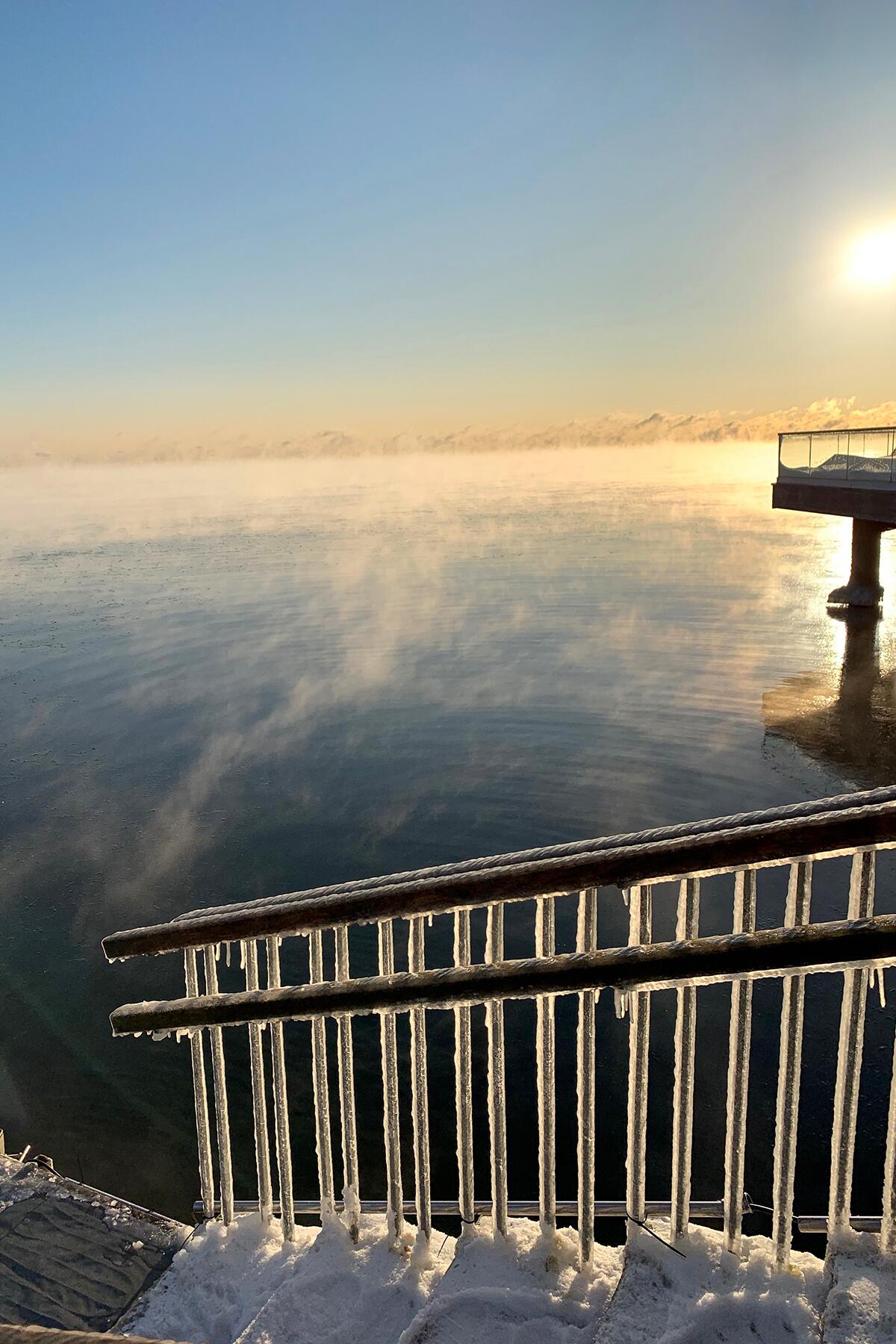It's the best way to find clarity.
There is no phrase more rhetorical in the Finnish language than “saako heittää?”
To an outsider, the sentence—“permission to throw?”—probably makes little sense. No mention of what is about to be thrown, or where it’s about to be thrown. But a Finn knows what’s coming. When you hear those words, you brace for “löyly”—two or three scoops of water thrown on rocks that have been heated for hours, if not days, the vapor raising the temperature in an already 170-degree sauna even higher. Instinctively, you lean forward and cup your ears to lessen the impact of the scalding steam on your body.
It may not sound like fun and games to everyone, but if you’re Finnish, the culture of endurance is ingrained in every cell of your being. If an event doesn’t involve undergoing pain of some sort, what was the point? With pain comes rebirth, whether it’s sweating out all toxins, overcoming a brutal hangover, or winning a war.
As much as I love a scorching sauna, winter bathing—that is, submerging yourself into 30-degree water, sometimes by drilling a hole in the ice—always seemed like too much of a Winter War simulation, even for me. I’ve never been a fan of cold water, to the point that I’ve only set foot once in the Pacific Ocean, despite spending 15 years in Los Angeles. Even then, I was wearing a wetsuit.
And yet, today, in 0-degree weather, I’m going swimming in the Baltic Sea. It is so cold that a cup of boiling water thrown into the air will turn into ice crystals the second it leaves the mug. Everywhere you look, Helsinki appears ripped straight out of The Day After Tomorrow. “Fully nuts,” is how my friend described my plans. Ironically, plunging into the not-even-metaphorically freezing ocean was the only thing keeping me sane.
Recommended Fodor’s Video
As someone who bolted out of her parents’ house and home-country at 19, it surprised even me that, when COVID-19 stopped the world in its tracks, my first instinct was to return home to Finland. But even after two decades of adventures abroad and my new home established in Paris, France, the truth was I knew that my safety was guaranteed in this country of exceptional healthcare and social stability.
Having thought this was a limited stay, I started to become unsettled when days turned into weeks and weeks into months. While Finland handled the pandemic well, and my family and I remained healthy, the return home was not without its hurdles. The regression back into childhood felt not only humiliating but often debilitating. In just the first 20 days of the pandemic, 20 years of hard work establishing a career in freelance writing felt erased, as colleagues I relied on for assignments were either fired or furloughed, budgets were frozen, and events I had covered for a decade were simply gone. With time standing still, my inner turmoil vacillated furiously between anxiety, anger, and depression. I wanted to crawl out of my skin, like something out of a Francis Bacon painting.
My true appreciation for the healing power of a sauna began in May, when on a weekend away at a friend’s summerhouse my anxiety hit its peak. Surrounded by idyllic red cabins, blue skies, and green forests evoking all the national romanticism and tranquility, I lay awake, frantically churning over who I was without the circumstances that formed my identity. While others had built their adult lives on a foundation of marriage and children, the pillars of my life were work, my friends, and unlimited mobility. How had I not seen this life that I loved for the house of cards that it was?
It was there, in the wood-fired sauna, surrounded by other naked women I’d known for but a second, that it suddenly seemed safe to express how utterly rudderless I felt, and—as millions of Finns before me—surrender to the safety of the only location we get to show vulnerability in. I discovered that I was completely accepted by these people—my people—in all my dread. They only knew me in the now, away from my ambitions, achievements, and, well, clothes. In a sauna, we all are equal, which is probably why centuries of political meetings have been held on those slabs.
That first time at the summer cabin, the temperature of the lake only allowed for quick plunges. There was no greater strategy to the submersion: You stood at the end of the pier and jumped in. But in that cold water, my anxiety was replaced by the kind of mindfulness people listen to thousands of hours of podcasts for. It’s really hard to self-loathe when you’re scrambling for solid ground. In the sauna, the world’s problems were solved, and in the icy water, they were put to rest—if not forever, at least for a much-appreciated reprieve.
True winter bathing, however, was a gradual discovery. My father’s apartment building, much like almost everyone else’s in a country that has 3.3 million saunas for 5.3 million inhabitants, has a communal sauna with allotted times for each resident. When indoor socializing again became untenable, my friends and I took over the Saturday night slot for the seaside sauna and did what we usually do—took cooling dips in the Baltic Sea between scoops of “löyly,” which we documented on social media with glee. The weekly date felt exceptionally clear in an otherwise mushy existence, marked by gray skies, short days, and ceaseless uncertainty.
Though dropping temps and violent storms whipping four-foot waves across the pier, we squealed, we swam, and, afterward, we unburdened what was left weighing on our minds in the enfolding heat. Despite my assessment that I was the only one failing at life in my pursuit of fierce independence, it was clear that neither house nor spouse had shielded anyone from the tremors of the global circumstances or, indeed, life. Inside this structure, we felt compelled to share, punctuating our weekly confessions with a plunge and a beer.
But, the week after Christmas, the ladder at the end of the pier was gone, halting future cold water therapy sessions. For a minute, facing this never-ending winter without my one lifeline felt shattering. I need not have worried though, as Helsinki is well-equipped for winter bathing. The easiest option, and my go-to for all guests from abroad, is Löyly, owned in part by actor Jasper Pääkkönen, best known for his role in Spike Lee’s BlacKkKlansman. The stunning wood structure, overlooking some of Helsinki’s most beautiful real estate and historic scenery, houses two unisex saunas leading out to a deck where one can plunge straight into the Baltic in every weather. This is exactly where we were headed on this day reminiscent of a cinematic apocalypse.
But in that cold water, my anxiety was replaced by the kind of mindfulness people listen to thousands of hours of podcasts for. It’s really hard to self-loathe when you’re scrambling for solid ground. In the sauna, the world’s problems were solved, and in the icy water, they were put to rest—if not forever, at least for a much-appreciated reprieve.
It’s my first time swimming in subzero temperatures and looking at the mist swirling across the surface of the water, I can feel my anxiety bubbling up. How had this hypothermic exercise seemed like a good idea? No matter. A real Finn does not retreat from a challenge, I tell myself.
When it’s this cold your instinct is to just get things over with, but where there is ice involved, submerging takes time. You have to consider the possibility of slipping, so even the short 30-foot walk to the water is a slow one. When you get to the ladder, there is the very real consideration that your hands will stick to the frozen metal. You never know what lays below the very dark surface, so you have to step into the bone-freezing water carefully. Once the water is up to my chest I find myself standing on something, and wonder if it is ice, since I don’t remember any rocks from previous visits. No choice but to bend the knees and crouch.
You might think that 36-degree water in 0-degree weather would feel like a jacuzzi, but you would be wrong. It is highly unpleasant. My friend and I are determined to stay in the water for 10 breaths and the best way to achieve this is to stay completely still while you breathe. Even the slightest movement is a sharp, stabbing reminder of the insanity of this endeavor. After 10 breaths we both grab onto the wood steps, climb up, plant our hands on the plastic runner that leads back to the building and shimmy up. I attempt to open the door and can feel my damp palm sticking to the metal handle. My friend removes her hat and uses it as an oven mitt to get us inside.
Back in the sauna, the rush is indescribable. I feel lightheaded and jittery, and the blood under the surface of my skin—which looks like an angry red spiderweb on a snow-white background—is pumping hard. Giddy from the endorphins we repeat the routine another four times until we’re completely blissed out. Turns out it’s almost impossible to come up with real-life worries—let alone coherent thoughts—after two hours of 160-degree temperature variations.
No amount of swimming takes away from the fact that the past year has been painful in so many ways. Even having found some peace in my own circumstances and overcoming my fear of personal regression and cold water, I am surely not the only one who would happily skip all reinvention exercises for the predictability of my old normal. But I know that when I am able to look back at this time, I will have forgotten the hours spent worrying about what was lost, and remember only my year reconnecting with family, friends, and a culture that is far more embracing of the goings-on in the ashes than the phoenix that eventually rises from them. The end may not yet be in sight, but, for now, I might as well make an adventure of the trials.





